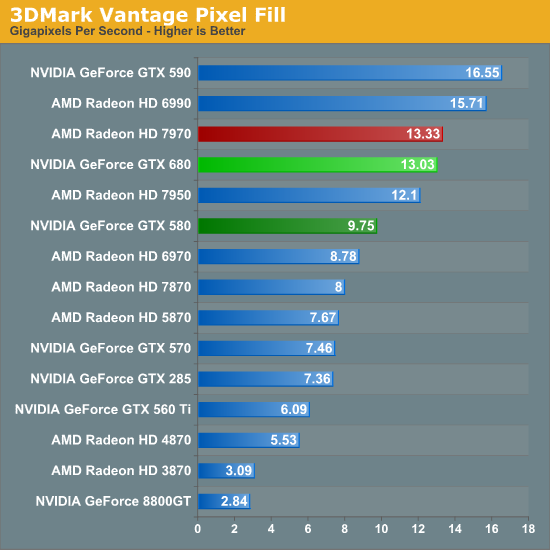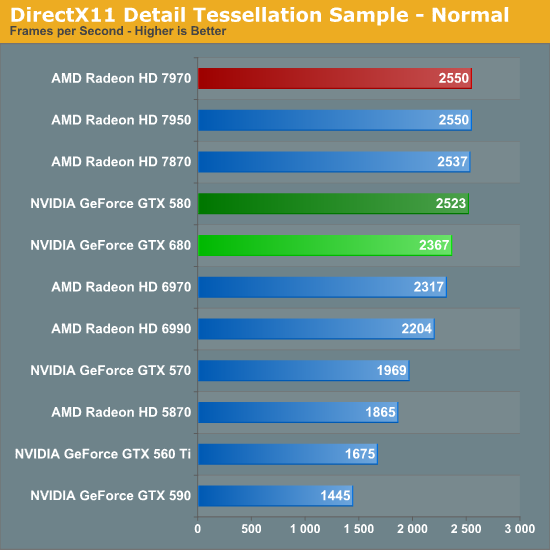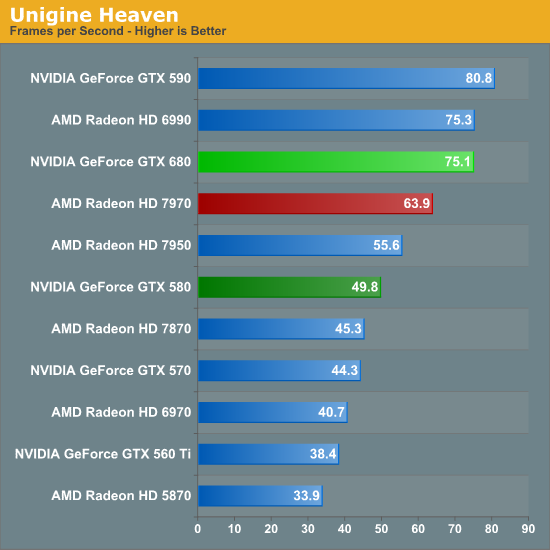NVIDIA GeForce GTX 680 Review: Retaking The Performance Crown
by Ryan Smith on March 22, 2012 9:00 AM ESTTheoreticals
As with any new architecture, we want to take a few moments to look at theoretical performance. These numbers shouldn’t be taken too seriously for cross-vendor comparison, but these numbers often tell us more about interesting architectural improvements that occur from one generation to the next.

Our first theoretical test is perhaps the most perplexing: 3DMark Vantage’s pixel fill test. Typically this test is memory bandwidth bound as the nature of the test has the ROPs pushing as many pixels as possible with as little overhead as possible, which in turn shifts the bottleneck to a mix of ROP performance and the memory bandwidth needed to feed those ROPs.
Compared to the GTX 580, the GTX 680 has almost exactly the same amount of memory bandwidth (192GB/sec) and only 86% of the theoretical ROP performance (37Gpix vs. 32Gpix). In short, it shouldn’t outperform the GTX 580 here, and yet it outperforms the 580 by 33%.
Why does it do this? That’s the hard thing to answer. As we mentioned in our look at GK104’s architecture, NVIDIA did make some minor incremental improvements to their ROPs coming from GF114, such as slightly improved compression and improved polygon merging. One of those may very well be the contributing factor, particularly the compression improvements since this is a typically memory bandwidth bottlenecked test. Alternatively, it’s interesting to note that the difference between the two video cards is almost identical to the difference in the core clock. GTX 560 Ti’s results tend to blow a hole in this theory, but it bears consideration.
In any case, it’s an interesting turn of events and hopefully one that isn’t simply an edge case. As we’ve seen in our benchmarks GTX 680 has strong performance – even if its lead compared to the 7970 diminishes with resolution – but compared to the GTX 580 in particular it needs strong ROP performance across all games in order to deliver good performance at high resolutions and anti-aliasing.

Our second theoretical test is 3DMark Vantage’s texture fill test, which to no surprise has the GTX 680 handily clobbering all prior NVIDIA cards. NVIDIA’s inclusion of 128 texture units on GK104 versus 64 on their previous generation GPUs gives the GTX 680 far better texturing performance. The 30%+ core clock difference only serves to further widen the gap.


Our third theoretical test is the set of settings we use with Microsoft’s Detail Tessellation sample program out of the DX11 SDK. Overall while NVIDIA didn’t make any significant changes to their tessellation hardware (peak triangle rate is still 4/cycle), they have been working on further improving performance at absurdly high tessellation factors. You can see some of this in action at the max factor setting, but even then we’re running into a general performance wall since the Detail Tessellation program can’t go to the absolute highest tessellation factors NVIDIA’s hardware supports.

Our final theoretical test is Unigine Heaven 2.5, a benchmark that straddles the line between a synthetic benchmark and a real-world benchmark as the engine is licensed but no notable DX11 games have been produced using it yet. In any case the Heaven benchmark is notable for its heavy use of tessellation, which means it’s largely a proxy test for tessellation performance. Here we can see the GTX 680 shoot well ahead of the GTX 580 – by more than we saw in the DX11 Detail Tessellation sample – but at the same time there’s a lot more going on in Heaven than just tessellation.
Honestly at this point in time I’m not sure just how much more tessellation performance is going to matter. Until DX11 is the baseline API for games, tessellation is still an add-on feature, which means it’s being used to add fine detail to specific models rather than being used on everything in a game world. This demands good tessellation at high factors but at the same time it’s subject to diminishing returns on the improvement to image quality as triangles reach single pixel sizes and smaller. To that end I’m still waiting to see the day where we see tessellation scale similarly to textures – that is by using full MIP chaining of displacement maps – at which point we can evaluate tessellation performance similar to texture performance when it comes to both measuring the performance hit and evaluating the difference in image quality.










404 Comments
View All Comments
saturn85 - Tuesday, March 27, 2012 - link
can we have folding@home benchmark?warmbit - Tuesday, March 27, 2012 - link
I invite you to the statement of GTX680 card performance based on the results of the eight websites (tom's too):http://translate.google.pl/translate?hl=pl&sl=...
lhotdeals - Wednesday, March 28, 2012 - link
I never posted a reply to reviews... but the conclusion of this review leaves me baffled. It is clear that 680 has its advantages, but looking at the numbers, the 680 and 7970 trades punches pretty equally in terms of performance. 680 does beat the 7970 in power usage and noise level, but the actual lead is miniscue...I do not see how the reviewer can reach the dominating position of the 680 in the conclusion... It is nothing but misleading to an otherwise great review with tons of data points.
sngbrdb - Wednesday, March 28, 2012 - link
"...at the end of the day it’s NVIDIA who once again takes the performance crown for the highest performing single-GPU card."Are you kidding me?? Are we looking at the same charts? This card only "excels" on the lower end of resolution and quality settings. And in many of your charts, the cards that beat it in higher resolutions are conspicuously absent in the lower-resolution charts (the GTX 590 and Radeon 6990 are frequently missing).
GPU reviews need to be written by someone who isn't biased toward a brand, and Mr. Smith, that is clearly not you.
CeriseCogburn - Thursday, March 29, 2012 - link
Sorry, you can't lie to yourself forever - how about a massive database with percentages and totals from many reviews...http://translate.google.pl/translate?hl=pl&sl=...
At the highest resolutions amd still loses. Amd also loses the lower and lowest Enjoy.
sngbrdb - Friday, March 30, 2012 - link
My comments are about the conclusions Mr. Smith draws form the charts he displays, not about whether the card does better elsewhere. The charts that Mr. Smith shows and the conclusions he draws from them are not logical... there may be other data out there that supports his conclusions, but that would mean the data he's displaying here is flawed/inaccurate. Either way, you can't look at those charts and act like the 680 has slaughtered AMD, you end up sounding like a fanboy.And charts need to be consistent about the cards being compared... you can't put a card in the chart for one resolution, and leave it out in another.
CeriseCogburn - Friday, March 30, 2012 - link
Yes, and anandtech's charts percentages are at the link I provided, that prove you incorrect, period.Reality doesn't make anyone a fanboy.Ignoring reality does.
_vor_ - Saturday, March 31, 2012 - link
So does replying to nearly all 40 pages of discussion flagrantly waving the NVIDIA banner. Maybe you need to look up the word hypocrisy.CeriseCogburn - Friday, April 6, 2012 - link
Vor you're angry because you got caught waving the amd flag * incorrectly*.There wouldn't be a need if there wasn't false information being spread about.
It's no wonder it happens when the amd card loses.
Addressing it is helpful and the right thing to do.
sngbrdb - Monday, April 9, 2012 - link
Um.... the charts at the link you provided point back to this article. Please do your research before being rude.From the article:
---------------------------------
Sources of data:
...
Anandtech - www.anandtech.com/show/5699/nvidia-geforce-gtx-680-review